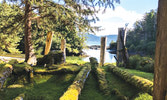Cultural protection: Haida Watchmen program


A dedicated group of Pontiac residents are working conscientiously to create the Friends of the Chats Falls. This summer the first Board was elected.
This sprawling piece of land beside the hydro-electric dam west of Quyon and east of Bristol has a fascinating human and natural history. For thousands of years First Nations portaged around its raging rapids. Probably summer settlements thronged the Ottawa River shoreline here, because they would have rested, swapped news, traded goods, and gathered food for the winter. Their presence is recalled at the Chats by “Indian Point.”
Then came the Europeans: Frenchman Joseph Mondion was the first settler in 1785 -- Mondion’s Point recalls his trading post whose foundations remain visible. After the explorers, Jesuits and settlers paddled past, then steamers plied the waters, the Horse Railway was constructed -- and then came the Grand Canal builders. Although this scheme of a canal failed, it left an extraordinary cut in the rocks right here at what used to be Pontiac Station, extending to Lac des Chats.
Pontiac connection to Haida
How does Chats Falls relate to the Haida Watchmen program, in Gwaii Hanaas National Park Reserve, British Columbia?
Both the Friends of Chats Falls and the Haida are determined to preserve and protect both the human and natural history of their special regions before they are lost.
This September, I was invited to Haida Gwaii, an archipelago off British Columbia’s coast once called the Queen Charlotte Islands. Here I met Haida hereditary chiefs plus cultural ambassadors. They explained that prior to European contact in the late 1700s, the Haida Nation numbered 30,000 - 40,000, but by the late 1800s only 500 or so remained, decimated by smallpox.
No wonder Haida are proud of reclaiming their language, preserving their culture, and creating jobs for Haida who have not only survived, but are thriving.
Here in the Outaouais, it’s prudent for us, too, to honour and recall our past. If we don’t know where we came from, how can we venture into our future with understanding and guardianship of natural habitats and human history?
The imperative: protecting Haida villages
The Haida decided they must protect their ancient villages -- partly because museum “scouts” and other visitor-vandals were removing artefacts. They started a guardianship program: Haida Watchmen, which is elegant in its simplicity.
Haida are educated about the history and culture of their people and trained in such skills as wilderness first aid. During summer, the guardians who are called Watchmen live at the ancient village sites in basic, comfortable housing. Each is a guide, where small groups of visitors are permitted to tour for about 1.5 hours, to learn about Haida culture.
During my latest trip, I met Captain Gold, who helped start the Watchmen program. Here is a partial fragment of my interview, where he recounts his harrowing solo canoe trip of some 250 km in stormy seas to visit SGang Gwaay. It’s one of five sites in this now-designated UNESCO World Heritage site. The concept of protection commenced with him and others lobbying for the villages’ protection during the early 1970s, where the Watchmen project commenced in 1981.
Captain Gold’s story
Captain Gold quietly told the story of his paddle to SGang Gwaay, the ancient Haida village off South Moresby Island.
“In my mind, I saw all these children pouring out of the village, running about me, splashing in the water and kelp. The rest of the village opened up to me: I could see it alive. I saw this lady packing a bent box. So many people laughing and welcoming me.
“I landed stern first: it’s what we did to show we come in peace, because if you landed bow first on the beach, you could be dangerous.
“I called to the people: ‘Forgive me if I make a mistake: I am only human.’ This is my prayer. It’s my life prayer, actually. The words just came.”
After landing, he flipped his canoe over, so he could stay overnight, protected. The following day he heard voices, “A Cape St. James research vessel approached. I heard clanging, they were lowering a canoe from a 25-foot boat. They were coming for a look.”
They also intended to remove artefacts, but Captain Gold prevented them from doing so.
“I had the feeling and knowledge I’d be there for twenty years.”
The Watchmen’s legacy
Captain Gold lobbied, with others, to create the Haida Watchmen, named for the traditional guardians who protected villagers from attack. Today’s Watchmen program sees two or three individuals stationed in five villages during the summer tourist season. (For more information, read the Coastal First Nations website: bit.ly/2yp9yuW Parks Canada site: bit.ly/2xO9V5j)
To me, the Board of the Friends of Chats Falls have an equally important legacy to protect our culture, our history -- and also, our endangered native species right here in the Pontiac, near Quyon and Bristol. I wish them -- and the Haida Watchmen -- good fortune as they protect our lands for our future generations.
Next Friends of Chats Falls meeting: October 29. Watch this column for details.
Katharine Fletcher is a freelance journalist, author and visual artist. Contact her at Katharine Fletcher fletcher.katharine@gmail.com


